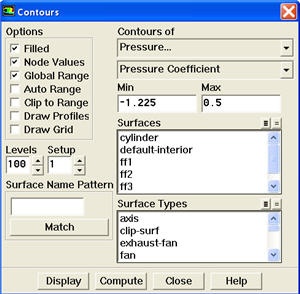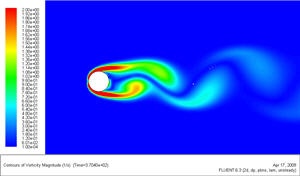...
| Info |
|---|
| title | Calculating Shedding Frequency |
|---|
|
| Wiki Markup |
|---|
To accurately calculate the shedding frequency, open the cl-history file (saved previously in the same location where the original mesh was read) and plot the data using excel for better data representation and graphing option. Take an average of 10 shedding cycles (e.g 10 CL peak).
\\
{latex}
\large
$$
{\rm{Period}} = {{T_2 - T_1} \over {10}}
$$
{latex}\\
\\
{latex}
\large
$$
{\rm{f}} = {{1} \over {Period}}$$
{latex}\\
\\
\\
\\
\\
\\
{latex}
\large
$$
{\rm{Sr}} = {fD \over U}
$$
{latex}
An example of Lift Convergence Plot plotted using excel is shown below:
!Excel Lift convergence_sm.jpg!
{newwindow:Higher Resolution Image}https://confluence.cornell.edu/download/attachments/107011458/Excel%20Lift%20convergence.jpg{newwindow}
|
|
...
Main Menu > Display > Contours
 Image Removed
Image Removed  Image Added
Image Added
Under Contours of, choose Pressure.. and Pressure Coefficient. Select the Filled option. Increase the number of contour levels plotted. Set Levels to 60 100. Disable Auto Range and Clip to Range from the Options group box. Enter -1.225 and 0.5 for Min and Max, respectively.Click Display.

...
Under Contours of, choose Velocity.. and Vorticity Magnitude. Disable Auto Range and Clip to Range from the Options group box. Enter 0.0001 and 2 for Min and Max, respectively. Select Levels to 6050. Click Display.

| newwindow |
|---|
| Higher Resolution Image |
|---|
| Higher Resolution Image |
|---|
|
https://confluence.cornell.edu/download/attachments/107011458/vorticity%20magnitude%20contour%20plot.jpg |
...
 Sign-up for free online course on ANSYS simulations!
Sign-up for free online course on ANSYS simulations!


